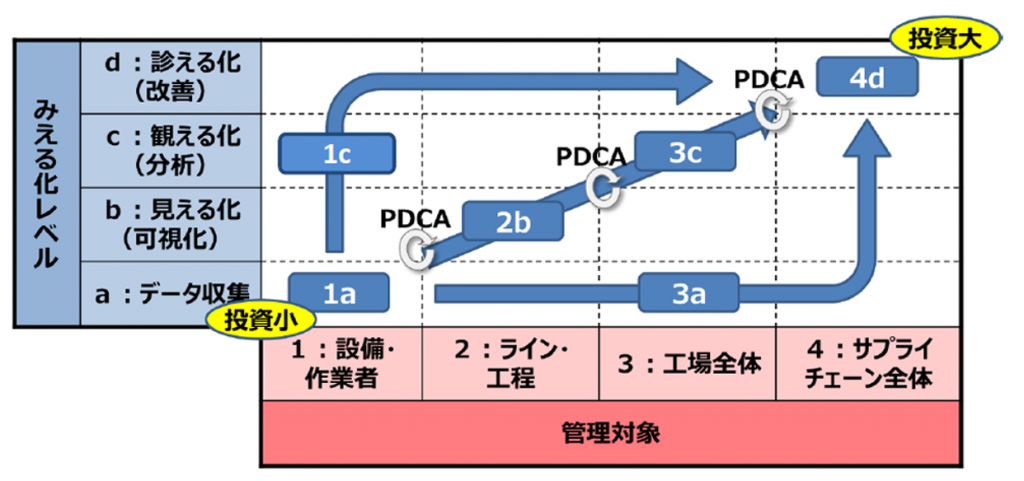DX (Digital Transformation) in the manufacturing industry is the use of digital technology to transform existing businesses and create new value.
Utilizing the data collected from the site, we will centrally manage all data from receiving, manufacturing process, inventory, and shipping.
As a result, we can improve operational efficiency and create “seeds” for creating new value as a company.
In this article, we will provide an easy-to-understand explanation of DX in the manufacturing industry and DX initiatives in Thailand, an overseas base.
Index ∇
1 What is DX?
2 DX in the manufacturing industry
2.1 What is DX in the manufacturing industry?
2.2 Challenges in manufacturing industry DX “2025” problem
2.3 Purpose of Manufacturing DX
2.4 Manufacturing industry DX utilization case
2.4.1 Case① Toyota Motor Corporation “Factory IoT“
2.4.2 Case② Daikin Industries, Ltd. “Factory IoT Platform“
3 DX situation in Thailand
3.1 Role of the Ministry of Digital Economy and Society
3.2 Structure of the Ministry of Digital Economy and Society
3.3 DX startup company investment by Digital Economy Promotion Organization
3.4 Examples of investments in DX startup companies
3.4.1 Case study① Thailand’s first car sharing service startup
3.4.2 Case study② Logistics efficiency digital service
3.4.3 Case study③ Energy saving system with DX
4 Summary: DX initiatives in the manufacturing industry and Thailand
What is DX?
DX is an abbreviation for Digital Transformation, and it is a hypothesis that “The penetration of IT will change people’s lives for the better in every aspect.” It is said to have been proposed by Eric Stolterman, a professor at Umea University in Sweden.
The Ministry of Economy, Trade and Industry’s “DX Recommended Guidelines” defines DX as follows.
“Companies can respond to drastic changes in the business environment, utilize data and digital technology, and transform their products, services, and business models based on the needs of customers and society. To transform our culture and climate and establish a competitive advantage.”
In the past, the goal and purpose was to “improve business efficiency” by utilizing IT and digital technology, but now there is a change in the purpose of “Reforming business models and organizations.”
DX in the manufacturing industry
DX aims to “change business models and organizations”.
Should we deal with such DX in the same way as in the manufacturing industry?
It is very important to consider the goals that can be achieved using DX while looking at the issues that Japanese companies are currently facing.
What is DX in the manufacturing industry?
Japan has set “Society 5.0” as the image of society that Japan should aim for, and in March 2017, it proposed the concept of “Connected Industries” as the image that Japanese industries should aim for.
Connected Industries refers to the connection of equipment, technology, and people by returning data, and is the way of industry that aims to create new added value and solve social issues. The key technologies are digital technologies such as IoT and AI.
DX (Digital Transformation) is the big change that this digital technology brings to the manufacturing industry.
Issues in manufacturing industry DX “2025” problem
A major risk that should not be overlooked as a major risk that hinders the DX (digital transformation) of the Japanese manufacturing industry is the problem of the core system.
According to a report by the Ministry of Economy, Trade and Industry’s “Study Group for Digital Transformation,” about 80% of Japanese companies have “legacy systems,” which raise the alarm about the problems of complexity, aging, and black boxes. ringing.
“Legacy systems” cannot fully utilize the explosively increasing amount of data, and there is a risk that it will be difficult to maintain and inherit the business foundation. In addition, it is expected that the risk of cyber security, system trouble due to accidents and disasters, and data loss and leakage will increase. If the “legacy system” remains, the economic loss due to the increase in risk due to the retirement of IT human resources and the end of support expected by 2025 will be up to 12 trillion yen/year (approximately three times the current level) from 2025 onwards. ).
We call this the 2025 Cliff. This “2025” problem also exists in Japan’s manufacturing industry, and its solution is an urgent issue.
Purpose of Manufacturing DX
As we are facing with the “2025 cliff” problem, improvement measures for “legacy systems” are an urgent issue.
On the other hand, according to the survey, it can be seen that a high percentage of respondents cited “improvement and transformation of business operations” and “transformation of existing business models” as the purpose of promoting DX.
As can be seen from these results, Japanese companies place the greatest emphasis on improving operational efficiency and improving and reforming business operations in IT investment, and that improving productivity is an issue that Japanese managers should prioritize. I understand.
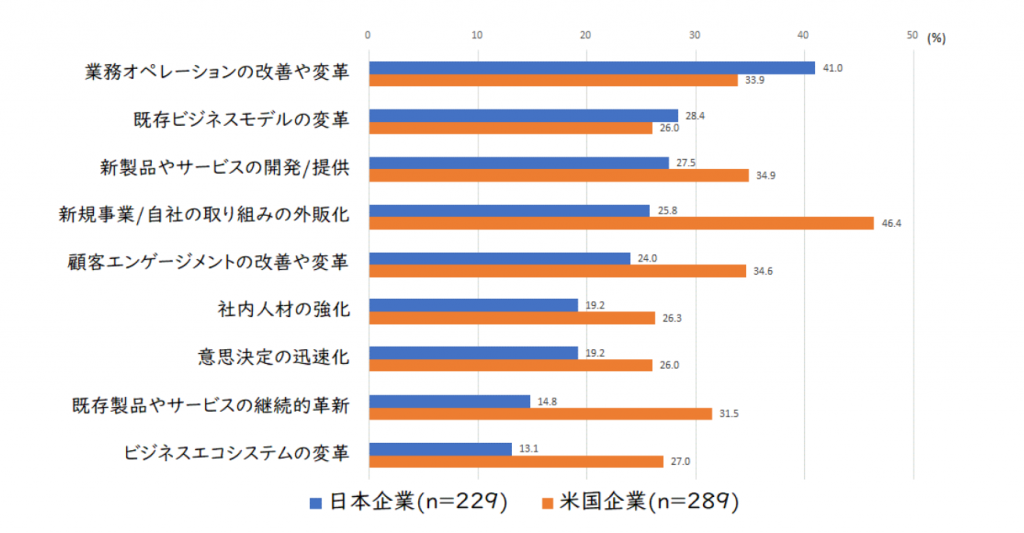
「我が国ものづくり産業の課題と対応の方向性に関する調査」(2019年12月)
Manufacturing industry DX utilization case
As companies focus on improving operational efficiency, what kind of DX measures are being implemented by companies?
Here, we will introduce DX cases of two companies as specific examples.
Case① Toyota Motor Corporation “Factory IoT”
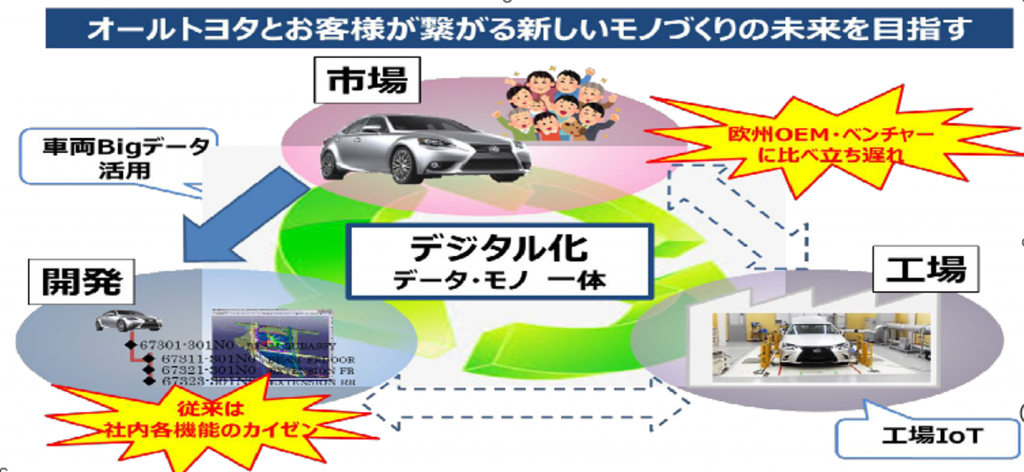
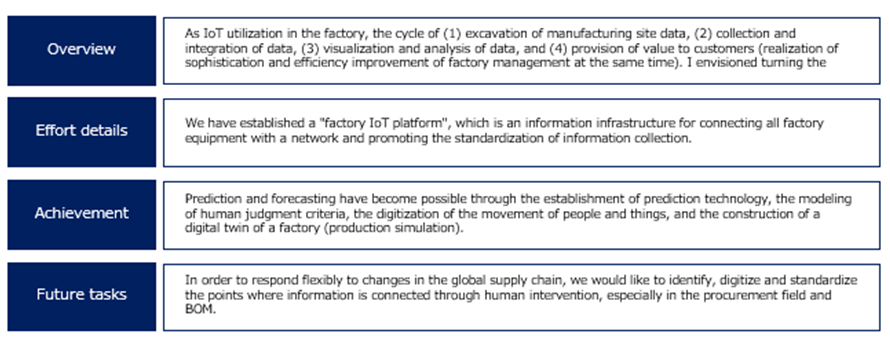
Case② Daikin Industries, Ltd. “Factory IoT Platform”
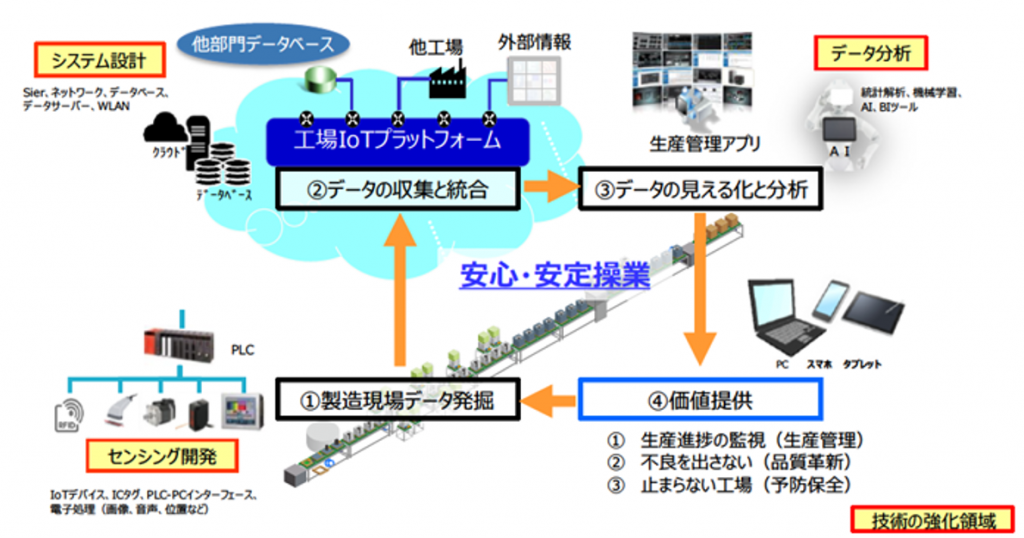
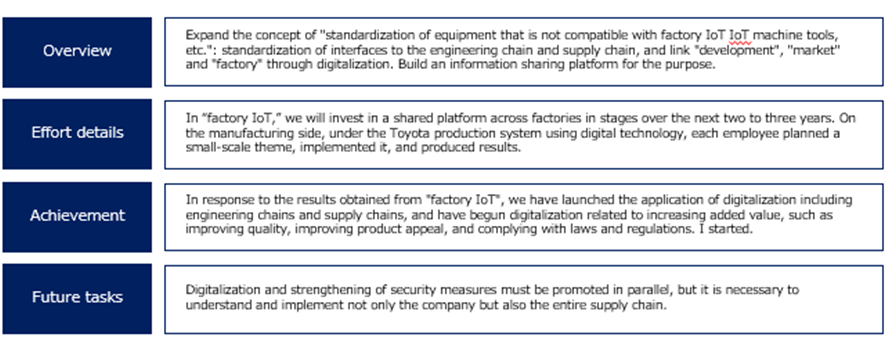
DX situation in Thailand
We will explain the status of DX initiatives in Thailand.
Thailand is promoting digitization and DX conversion, mainly by the Thai government’s Ministry of Digital Economy and Society (กระทรวงดิจิทัลเพื่อเศรษฐกิจและสังคม).
Here, we will explain the vision, mission, and initiatives of the Ministry of Digital Economy and Society.
Role of the Ministry of Digital Economy and Society
Thailand established the Ministry of Information and Communication Technology in October 2002 to promote the country’s digitalization. Later, on September 16, 2016, the Ministry of Digital Economy and Society (กระทรวงดิจิทัลเพื่อเศรษฐกิจและสังคม) was renamed to its current name, and ministries, departments, and departments were revamped.
We are responsible for planning, promoting and developing the digital economy in Thailand, and our vision is to “lead the utilization of technology and digital innovation towards Thailand 4.0”.
We have the following six missions:
Digitization of the economy and society, statistics, meteorological policies, national plans and legal proposals. Build confidence in using digital technology safely and reliably.
Developing, managing and supervising the communication, information and telecommunications infrastructure for the country’s economic and social development.
Promote and support the use of technology and digital innovation Continue research and development such as developing digital manpower Increase the country’s competitiveness and improve people’s quality of life.
Promote the integration and efficiency of administrative work by linking information from multiple institutions with digital technology.
Manage the national statistical system. Not only promotes and develops meteorology that supports decision-making, but also responds to the needs of his service users in time to be effective.
To supervise, monitor and evaluate economic and social digital development, statistics, meteorological policies, national planning and legislation. Build confidence in using digital technology safely and reliably.

Structure of the Ministry of Digital Economy and Society
The Ministry of Digital Economy and Society is accompanied by four public bodies and state-owned enterprises.
1. National Telecommunications Public Company Limited (บริษัท โทรคมนาคมแห่งชาติ จำกัด )
2. Thai Post Co., Ltd. (บริษัท ไปรษณีย์ไทย จำกัด)
3. Digital Economy Promotion Organization (สำนักงานส่งเสริมเศรษฐกิจดิจิทัล)
4. Electronic Transaction Development Agency (สำนักงานพัฒนาธุรกรรมทางอิเล็กทรอนิกส์)
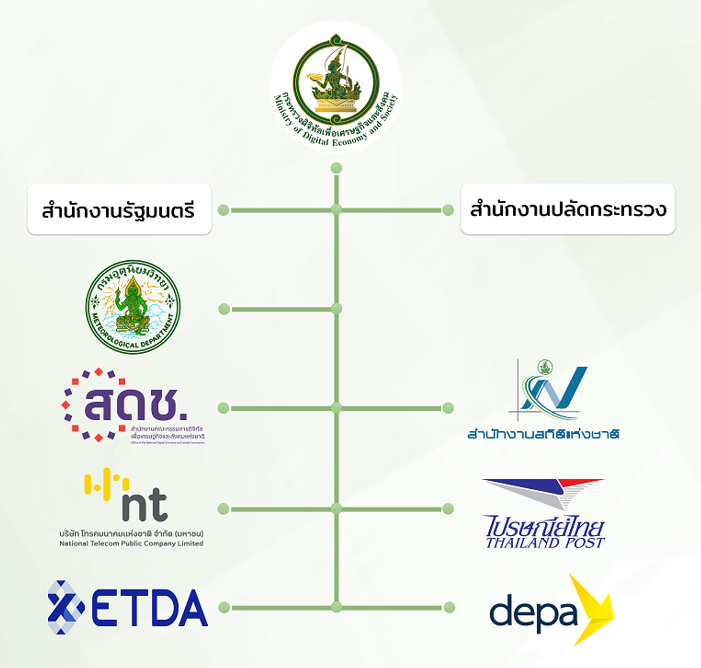
DX startup company investment by Digital Economy Promotion Organization
Digital Economy Promotion Agency (Digital Economy Promotion Agency สำนักงานส่งเสริมเศรษฐกิจดิจิทัล) is actively investing in DX startup ventures in Thailand.
Besides investment, it is also used as a venue for activities to build a network of digital startups and technology entrepreneurs.
In both domestic and overseas markets, training activities to scale up business and business matching activities to expand business opportunities will be carried out.

Examples of investments in DX startup companies
Digital Economy Promotion Agency Commonly known as: I would like to introduce an example of what kind of companies depa invests in.
Case study① Thailand’s first car sharing service startup
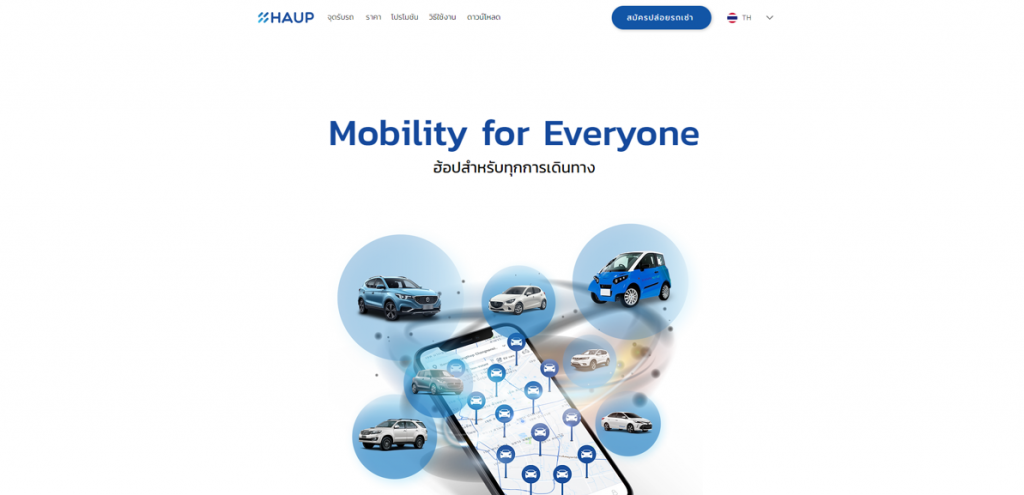
Company name:
Haupcar (บริษัท ฮ้อปคาร์ จำกัด)
Business description:
Hopcar is Thailand’s first car sharing service startup.
24 hours a day through an application to book a car dispatch, open and lock the car,
“Can be used by the hour without paying daily.”
Website:
http://www.haupcar.com/
Case study② Logistics efficiency digital service

Company name:
Logisty (บริษัท โลจิสตี จำกัด)
Business description:
“Logistics” connects transportation service providers and exchanges jobs and vehicles
A platform that maximizes profits.
Improve customer service and reduce car idle problems.
Website:
http://www.haupcar.com/
Case study③ Energy saving system with DX
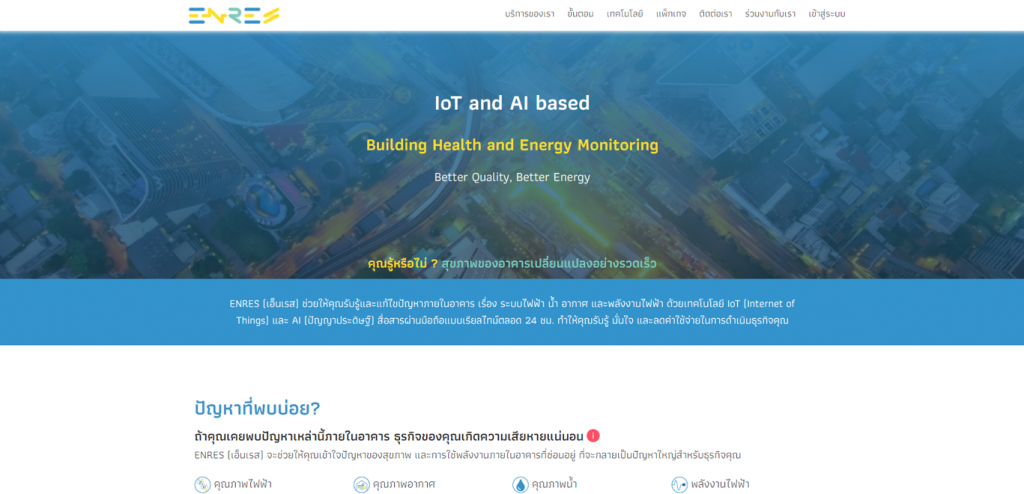
Company name:
ENRES (Energy Response Company Limited) (บริษัท เอ็นเนอร์จี้ เรสปอนส์ จำกัด)
Business description:
The management of commercial buildings and factories consists of multiple systems.
In order to further improve the management efficiency of commercial buildings and factories, ENRES will utilize IoT technology to
Introduce sensors and control systems.
Artificial intelligence technology AI is used to collect the large amount of data received from all sensors
processing to achieve the most efficient control and minimize power consumption
It will be possible. “This will further reduce energy consumption.”
Compatible with smart cities by controlling electrical systems in districts and cities
Reduce peaks and electricity consumption across the city.
Website:
http://www.haupcar.com/
Future Policy of Digital Economy Promotion Organization
Thailand’s first vehicle dispatch application service, but not listed here, Thailand’s first vehicle dispatch application, massage reservation system, financial platform using blockchain, and business startups in various fields. increase.
Utilize IoT and AI to maximize electrical efficiency. It is targeted at commercial buildings and factories, which consume a particularly large amount of power, and is a necessary solution in Thailand, which is troubled by the problem of self-sufficient power.
Logisty is a platform that streamlines delivery. If you register on the platform and place a delivery request, it will maximize the delivery efficiency, so you can deliver in the best way for your customers.
With the recent development of the e-commerce market in Thailand, it is an area where further demand can be expected.
The Digital Economy Promotion Agency depa’s mission is to increase the number of competitive digital start-ups by creating possibilities for these digital start-ups by leveraging digital technology.
Summary: DX initiatives in the manufacturing industry and Thailand
For DX in the manufacturing industry, it is important to envision the ultimate goal and start small.
Even in Japanese companies in Thailand, the number of places where data collection using IoT tools is being introduced is increasing.
However, at this stage, I think that the current situation is that the data is not fully utilized.
This is the roadmap to DX set by Mitsubishi Electric Corporation.
Ultimately, it will be a roadmap that aims to acquire information starting from the manufacturing site with factory equipment IoT through a system that links production information and IT, and to analyze and utilize data in real time.
By proceeding from the initial stage of information gathering, it is possible to realize realistic DX that is not unreasonable even at the factory.
By performing a bird’s-eye view analysis of the engineering chain and supply chain, it becomes possible to aim for productivity improvement and cost improvement for manufacturing as a whole.
